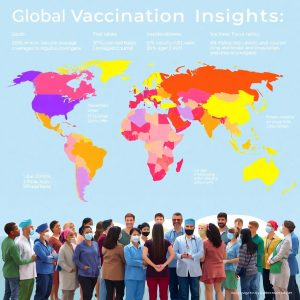
Vaccination has been a cornerstone of global public health for decades, preventing millions of deaths from infectious diseases each year. From eradicating smallpox to controlling polio and mitigating the impact of COVID-19, vaccines have transformed the health landscape. Understanding global vaccination rates and the factors influencing them provides critical insights into the progress and challenges of achieving widespread immunization.
The Global Picture of Vaccination Rates
Vaccination rates vary significantly across countries and regions. According to data from the World Health Organization (WHO) and UNICEF, high-income countries tend to achieve higher vaccination rates due to better healthcare infrastructure, public awareness, and government support. For example, countries like the United States, Germany, and Japan consistently report immunization rates above 90% for essential vaccines such as measles, mumps, and rubella (MMR).
In contrast, many low- and middle-income countries face challenges in reaching similar rates. While progress has been made in expanding access to vaccines, regions such as sub-Saharan Africa and parts of Southeast Asia still struggle with coverage gaps. Issues such as inadequate healthcare infrastructure, vaccine misinformation, and logistical challenges in remote areas hinder immunization efforts.
For instance, the global rollout of COVID-19 vaccines highlighted disparities in access and distribution. While countries like the United Kingdom and Canada achieved vaccination rates exceeding 70% within months, others, including many in Africa, lagged behind due to limited vaccine supplies and logistical barriers.
Key Factors Influencing Vaccination Rates
Several factors contribute to disparities in vaccination rates:
- Healthcare Infrastructure: Countries with well-established healthcare systems can more effectively distribute and administer vaccines, ensuring higher coverage rates.
- Education and Awareness: Public knowledge about the importance of vaccines plays a vital role in acceptance. In some regions, vaccine hesitancy fueled by misinformation has led to lower uptake.
- Economic Resources: Wealthier nations can afford to invest in vaccine procurement and distribution, whereas low-income countries often rely on international aid and initiatives like COVAX.
- Cultural and Religious Beliefs: In some areas, cultural or religious beliefs may influence perceptions of vaccines, affecting acceptance rates.
- Government Policies and Campaigns: Strong governmental support through immunization programs and public health campaigns has proven essential in boosting vaccination rates.
Insights from Data and Progress
Global data reveals encouraging trends in immunization. The WHO reports that childhood immunization coverage for diseases such as diphtheria, tetanus, and pertussis (DTP3) has steadily increased, protecting millions of children annually. Additionally, international collaborations, such as Gavi, the Vaccine Alliance, have played a pivotal role in improving vaccine access in low-income countries.
COVID-19 has also underscored the importance of global solidarity. Efforts to ensure equitable vaccine distribution, including donations from high-income nations and the COVAX initiative, have helped bridge some gaps. However, achieving equitable vaccination rates requires sustained commitment to addressing supply chain challenges, combating misinformation, and investing in healthcare infrastructure.
The Road Ahead
To ensure robust global vaccination rates, concerted efforts must continue. Governments, non-governmental organizations, and international bodies must collaborate to improve vaccine access, enhance public education, and address logistical challenges.
Vaccination is more than just a public health tool; it is a global responsibility. By understanding the insights and data behind vaccination rates, the world can take targeted actions to ensure that life-saving vaccines reach every corner of the globe, protecting individuals and communities alike.